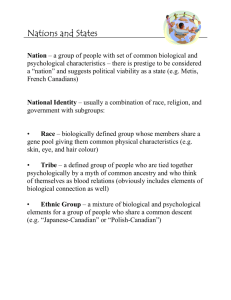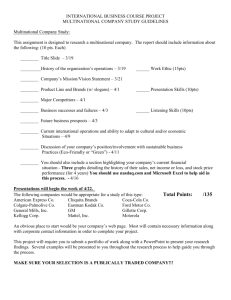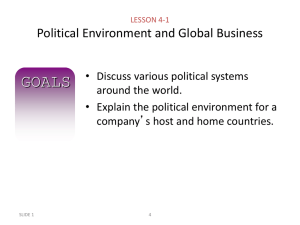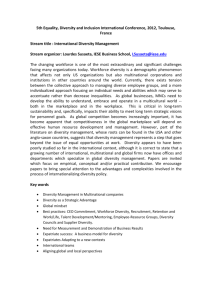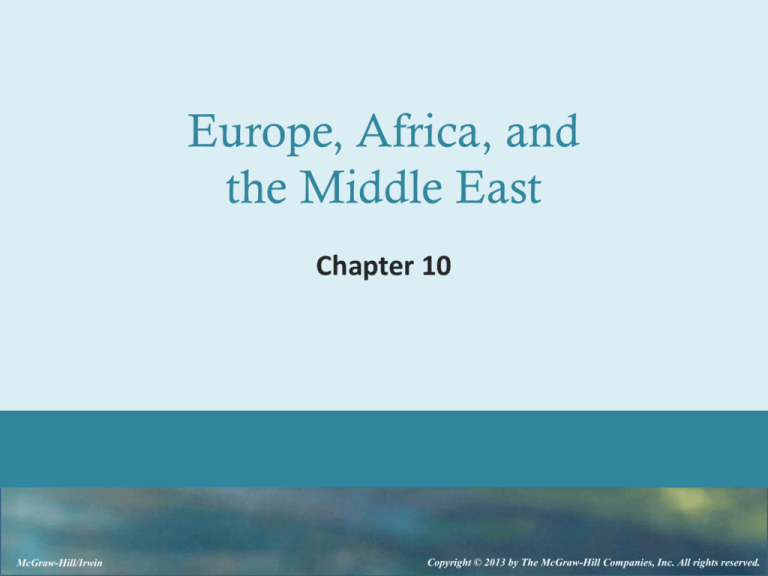
Europe, Africa, and
the Middle East
Chapter 10
McGraw-Hill/Irwin
Copyright © 2013 by The McGraw-Hill Companies, Inc. All rights reserved.
Learning Objectives
LO1
LO2
LO3
LO4
The reasons for economic union
Patterns of international cooperation
The evolution of the European Union
Evolving patterns of trade as eastern Europe and
the former Soviet states embrace free-market
systems
LO5 Strategic implications for marketing in the region
LO6 The size and nature of marketing opportunities
in the European/African/Middle East regions
10-2
Within a short walk of one another in the Old City of Jerusalem are three of the
most important holy sites for Muslims (the Dome of the Rock), Jews (the Wailing
Wall), and Christians (the Church of the Holy Sepulchre). Peace in the region
would yield a bonanza of religious tourism.
10-3
Regional Market Regions and
Regional Economic Cooperation
Multinational market regions are groups of
countries that seek mutual economic benefit from
reducing interregional trade and tariff barriers—are
the most important global trends today
The most successful one is the European Union (EU),
the world’s largest multinational market region and
foremost example of economic cooperation
Multinational market groups form large markets that
provide potentially significant opportunities for
international business.
10-4
La Raison d’Etre
Successful economic union requires favorable
economic, political, cultural, and geographic factors
as a basis for success
The advantages of economic union must be clear-cut
and significant
Benefits must greatly outweigh the disadvantages
before nations forgo any part of their sovereignty
10-5
Economic Factors
Usually markets are enlarged through preferential
tariff treatment for participating members, common
tariff barriers against outsiders, or both
Enlarged, protected markets stimulate internal
economic development
External and internal barriers are reduced because of
the greater economic security afforded to domestic
producers
For a union to survive, it must have agreements and
mechanisms in place to settle economic disputes.
10-6
Political Factors
Political amenability among countries is another
basic requisite for the development of a market
agreement
Typically, marketing arrangements are made in
response to external political threats
Participating countries must have comparable
aspirations and general compatibility before
surrendering any part of their national sovereignty
10-7
Geographic and Temporal Proximity
Although not absolutely imperative for cooperating
members of a customs union, such closeness facilitates
the functioning of a common market
More important than physical distance are differences
across time zones
Trade tends to travel more easily in north–south
directions than it did in ancient times
Transportation networks are interrelated and well
developed when countries are close together
Issues of immigration, legal and illegal, also promote
closer economic integration
10-8
Cultural Factors
Cultural similarity eases the shock of economic
cooperation with other countries
• Members understand the outlook and viewpoints of their
colleagues
Language, as a part of culture, has not created as much a
barrier for EU countries as was expected
• Nearly every educated European can do business in at least two
or three languages
Religion, however still seems to be an issue, as evidenced
by the impending membership of turkey into the EU
• Key members share a long-established Christian heritage
10-9
Patterns of Multinational Cooperation
Regional Cooperation Groups
Free Trade Area
Customs Union
Common Market
Political Union
10-10
Regional Cooperation Groups
The most basic economic integration and
cooperation is the regional cooperation for
development (RCD)
Governments agree to participate jointly to develop
basic industries beneficial to each economy
Each country makes an advance commitment to:
• participate in the financing of a new joint venture
• to purchase a specified share of the output of the venture
10-11
Free Trade Area
A free trade area (FTA) requires more cooperation
and integration than the RCD
It is an agreement between two or more countries to
reduce or eliminate customs duties and nontariff
trade barriers among partner countries
Members maintain individual tariff schedules for
external countries.
An FTA provides its members with a mass market
without barriers to impede the flow of goods and
services
10-12
Customs Union
A customs union represents the next stage in
economic cooperation
It enjoys the free trade area’s reduced or eliminated
internal tariffs and adds a common external tariff on
products imported from countries outside the union.
The European Union was a customs union before
becoming a common market
Customs unions exist between France and Monaco,
Italy and San Marino, and Switzerland and
Liechtenstein, to name some examples.
10-13
Common Market
A common market agreement eliminates all tariffs
and other restrictions on internal trade
Adopts a set of common external tariffs, and
removes all restrictions on the free flow of capital
and labor among member nations
It is a unified economy and lacks only political unity
to become a political union
10-14
Political Union
Political union is the most fully integrated form of
regional cooperation
It involves complete political and economic integration,
either voluntary or enforced
The most notable enforced political union was the
Council for Mutual Economic Assistance (COMECON), a
centrally controlled group of countries organized by the
Soviet Union
Two new political unions came into existence in the
1990s:
• the Commonwealth of Independent States (CIS), made up of the
republics of the former Soviet Union, and
• the European Union (EU)
10-15
Global Markets and
Multinational Groups
The restructuring of the eastern European bloc into
independent market-driven economies
The dissolution of the Soviet Union into independent
states
The worldwide trend toward economic cooperation
Enhanced global competition
All of these warrant the study of three multinational
regions: Europe, Africa and Middle East
10-16
Europe and European Integration
Within Europe, every type of multinational market grouping
exists:
• The European Union
• European Economic Area,
• The European Free Trade Area
No other group is more secure or more important economically
than the EU
It has made progress toward achieving the goal of complete
economic integration and, ultimately, political union
There are language and cultural differences, individual national
interests, political differences, and centuries-old restrictions
designed to protect local national markets
Historically, standards have been used to effectively limit market
access to individual countries (Germany: Beer, Italy: Pasta)
10-17
*Current U.S. $.
eEurozone.
Source: Euromonitor International, 2012; World Bank, 2012
.
10-18
10-19
10-20
European Union
Even though several member states are not fully
implementing all the measures, they are making
progress
The proportion of directives not yet implemented in
all 27 member states has fallen dramatically
Taxation has been one of the areas where
implementation lags and reform continues to be
necessary
10-21
EU Institutions
It has executive, parliamentary, and judicial
branches:
• the European Commission: initiates policies
• the Council of Ministers: is the decision-making body of
the European Union
• the European Parliament: can amend and adopt legislation
• the Court of Justice: is responsible for challenging any
measures incompatible with the Treaty of Rome, for
passing judgment at the request of a national court, on the
interpretation or validity of points of EU law
10-22
Economic and Monetary Union (EMU)
The EMU, a provision of the Maastricht Treaty,
established the parameters of the creation of a
common currency for the EU, the euro
Established a timetable for its implementation
In 2002, a central bank was established, conversion
rates were fixed, circulation of euro banknotes and
coins was completed
The 12 member states employed the euro beginning
in January 1, 2001, some did not join voluntarily
10-23
Expansion of the European Union
Ten new countries were added in 2004, some ahead
of schedule
Bulgaria and Romania entered as planned in 2007
Talks with Turkey, Macedonia, and Croatia are
continuing
Negotiations with Turkey have had their ups and
downs, but the Muslim majority nation has
economically benefited from its new openness
10-24
Expansion of the European Union
In 2007 the European Union celebrated its golden
anniversary
The 2008–2009 global recession has posed daunting
short-term challenges to the integrity of the Union
An early recovery stalled in late 2009; and Ireland,
Portugal, Spain, and particularly Greece are
experiencing continuing problems.
10-25
Long Term Challenges for the EU
The long term challenges facing the Union in the next
50 years appear to fall into three categories:
• improving the Union’s economic performance
• deciding how to limit the political aspect of union and
• deciding about further enlargement
10-26
Eastern Europe and the Baltic States
Eastern Europe and the Baltic states, satellite nations
of the former Soviet Union, have moved steadily
toward establishing post communist market reforms
New business opportunities are emerging
Countries continue to adjust to the political, social,
and economic realities of changing to free markets
and capitalism.
10-27
Eastern Europe
Most eastern European countries are privatizing
state-owned enterprises
Establishing free market pricing systems
Relaxing import controls
But struggling with inflation
The very different paths taken toward market
economies have resulted in different levels of
progress
10-28
Baltic States
The Baltic states—Estonia, Latvia, and Lithuania—are a
good example of the difference that the right policies can
make
All three countries started off with roughly the same
legacy of inefficient industry and Soviet-style command
economies
Government bureaucracy, corruption, and organized
crime—common problems found in the countries of the
former Soviet Union continue
These issues represent the most significant hurdles to
U.S. trade and investment
10-29
Commonwealth of Independent States
The first Soviet republics to declare independence
were the Baltic states
The remaining 12 republics of the former USSR,
collectively known as the Newly Independent States
(NIS), regrouped into the Commonwealth of
Independent States
The CIS is a loose economic and political alliance with
open borders but no central government
10-30
The hammer and sickle logo of the old USSR has been replaced by signs of free
enterprise in Russia. Here in the main shopping district of St. Petersburg, Nike
Sport is prominent, along with Coca-Cola red umbrellas.
10-31
10-32
Africa
Recent global economic problems have not impeded the
growth among African countries
Ethiopia, Angola, and Malawi each experienced annual
growth rates of greater than 8 percent between 2007 and
2011
Several other countries in the sub-Saharan region have grown
faster than 5 percent annually
However, Africa’s multinational market integration activities
can be characterized as a great deal of activity but little
progress
Despite the large number and assortment of paper
organizations, there has been little progress towards
economic integration because of political instability
10-33
Exhibit
10.6
*Current U.S. $.
1 Member of Economic Community of West
African States (ECOWAS).
2 Member of Southern African Development
Community (SADC).
3 Member of East African Community.
Source: Euromonitor International, 2012;
World Bank, 2012.
10-34
Middle East/North Africa (MENA)
The ongoing political turmoil in Middle East/North
Africa (MENA) region accelerated in 2011 and has
resulted in economic disaster in several countries in
the region
The Arab Common Market set goals for free internal
trade but has not really succeeded
• The aim was to integrate the economies of the 22 Arab
countries, but a long history of border disputes, and
internal political turmoil will have to be overcome.
10-35
Middle East/North Africa (MENA)
The Arab Gulf states, Egypt, and Morocco formed an
Arab Free Trade Area, sometimes called the Greater
Arab Free Trade Area (GAFTA)
Iran, Pakistan, and Turkey, formed the Regional
Cooperation for Development (RCD), recently
renamed to the Economic Cooperation Organization
(ECO)
The organization, led by Iran, is the Organization of
the Islamic Conference (OIC), a common market
composed of Islamic countries
10-36
Exhibit
10.7
Middle
East/North
Africa
(MENA)
*Current U.S. $.
Source: Euromonitor International, 2012; World Bank, 2012.
10-37
Implications of Market Integration
Multinational provide opportunity through access to
greatly enlarged markets
Production, financing, labor, and marketing decisions
are impacted
World competition will continue to intensify as
businesses become stronger and more experienced
in dealing with large market groups.
Regulation of business activities has been intensified
throughout multinational market groups
10-38
Opportunities
Economic integration creates large mass markets.
Most multinational groups have coordinated
programs to foster economic growth
Major savings will result from the billions of dollars
now spent in developing different versions of
products to meet a variety of national standards.
10-39
Market Barriers
Provide an advantage to the companies within the
market in their dealings with other countries of the
market group
Companies willing to invest in production facilities in
multinational markets may benefit from protectionist
measures
Exporters to these markets are in a considerably weaker
position
Meeting product and other standards within each
multinational marketing region like the EU is a challenge
10-40
10-41
10-42
10-43
Marketing Mix Implications
In the past:
• Companies charged different prices in different countries
• Non-tariff barriers between member countries supported
such price differentials
Companies are adjusting their marketing mix
strategies to reflect anticipated market changes in
the single European market.
•
•
•
•
Price standardization due to parallel importation
Fairer competition due to single currency (EU)
Reduced number of brands due to standardization
Increased competition among retailers
10-44



